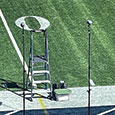One of my favorite courses as an undergraduate was History of the Symphony. It was taught by Charles Warren Fox (1904-1983) who was the first musicologist hired at the Eastman School of Music. Fox had been educated at Cornell where he studied psychology and musicology with the famous Otto Kinkeldey. Fox helped found the American Musico-logical Society and was editor of its journal as well as editor of Notes, the publication of the Music Library Association. He taught countless numbers of students sharing his love of the Haydn Symphonies among other works.
Another professor of mine told me that Fox had risen to fame early in his career because of an article he had written where he traced the progression of an incorrect fact through years of publications. His point was when writing an article don’t rely on any previous research. Start again and verify everything. According to my professor, this was the standard Fox held authors to in his years as editor of the Journal of the American Musicological Society (JAMS).
When writing program notes for our local symphony, I was researching Italian Baroque composer Antonio Vivaldi’s (1678-1741) flute concerto known as Il Gardellino or the Goldfinch concerto. The work in three movements (Allegro, Cantabile, Allegro) was written in 1728 and published in 1729. The exact title is Concerto in D Major, RV 428, Op. 10, No. 3 “Il Gardellino.” I had just bought a new Italian dictionary and decided to look up the word Gardellino. It was not listed, but Cardellino was and it meant “The Goldfinch.” Today 289 years later, the word is still improperly used in research and on music and recording publications. It is easy to see how this mistake was originally made. The font for the G could have been easily confused with one for a C. Charles Warren Fox was right—check the facts.
Did you ever wonder about the authorship of some of the items in the Taffanel et Gaubert Complete Method? When I was a student, William Kincaid mentioned that the Mozart Cadenzas were by the Belgian musicologist and composer Francois-August Gevaert (1828-1908). Later I read that the etudes were by the Italian flutist Giuseppe Gariboldi (1833-1905) (See The Flute by Ardal Powell, p. 222) and the famous T & G No. 4 is based on the scale patterns from The Flute School, Op. 205 by Wilhelm Popp (1828-1903) (Idea first shared by Trevor Wye). The Popp version uses the melodic minor form throughout rather than the inconsistent minor forms in the Taffanel. While this probably will not influence how you practice and play these studies and scale patterns, it is interesting to know their derivation.
A good part of my job as editor is to check facts and verify the assumptions authors make. I am amazed that writers who graduated from The Juilliard School of Music spell the name of the institution incorrectly. Certainly today with the access to Google and other search engines a moment here and there would improve scholarship immensely. Composers are especially sensitive about the spelling of their names: Copland rather than Copeland; Handel rather than Handle; and of course, the two with the same sounding name – Haydn and Heiden.
With the beginning of the school year and performing season, take the time to set a new standard for yourself and your studio. For each piece studied, research the composer and the society in which he or she lived. Research the style period and other art forms from the time to discover influences the composer may have had. Listen to as many recordings as possible. Compare performances and verbalize or write down comparisons. For works with more than one edition, peruse various versions as newer ones may have fresher scholarship although the older ones are also important.
IMSLP (www.imslp.org) is a wonderful source for finding the first editions of works. Often it is the manuscript that is uploaded there, so you can see what the composer intended before it was engraved and published. Most of the early French Conservatory examination pieces may be found here. These editions are lovely and, in many cases, the printing font is larger and easier to read than the modern printed editions. You may download and print several copies at once so in your studies you can mark up the music for what you need at the time.
Michel Debost shared with me that he wondered if we could tell the composer’s intent by how close together the notes were in Baroque pieces, especially when it applied to figuration. After looking at many manuscript scores, this may be a distinct possibility. If possible try playing Baroque and Classic music on a traverso. You are welcome to perform early music on a modern flute, but you will make different decisions if you have played it also on a traverso.
At the start of the fall season make new goals and attend as many live performances as you can this year. The pieces you enjoy may lead to discovering new repertoire for the flute and even better you will be supporting your colleagues. Scholarship matters and our lives are richer for it.
“According to legend, perpetuated in the Academy Award winning film Amadeus, Mozart died in poverty and was thrown in a pauper’s grave. Let’s set the record straight. Mozart’s average annual income for the last decade of his life, as my own research shows, was approximately $300,000 – he earned a great deal of money but quickly spent that and more, in the end leaving about $100,000 in debts.[i] But lest there be any doubt about Mozart’s attitude toward money, consider what he wrote in 1782 soon after his arrival in Vienna: ‘If [the Emperor] wants me, he must pay me, for the honor alone of serving him is not enough. Indeed, if he were to offer me one thousand gulden and some Count two thousand, I should decline the former proposal with thanks and go to the Count.’[ii] As to that pauper’s grave, burial in a common plot was standard for 80% of the populace of Vienna at this time.[iii] Mozart was no starving artist.”
[i] See also, William J. Baumol and Hilda Baumol, “On the Economics of Musical Composition in Mozart’s Vienna,” in James M. Morris, On Mozart (Cambridge, 1994), pp. 72-101, and Volkmar Braunbehrens, Mozart in Vienna: 1781-1791, trans. Timothy Bell (New York, 1986), pp. 424-428.
[ii] Letter of April 10, 1782, in Anderson, Letters, pp. 799-800.
[iii] Volkmar Braunbehrens, Mozart in Vienna: 1781-1791, trans. Timothy Bell (New York, 1989), p. 421.
– Excerpt from Craig Wright, The Hidden Habits of Genius (Harper Collins, to appear 2019), chapter “Money Matters”






